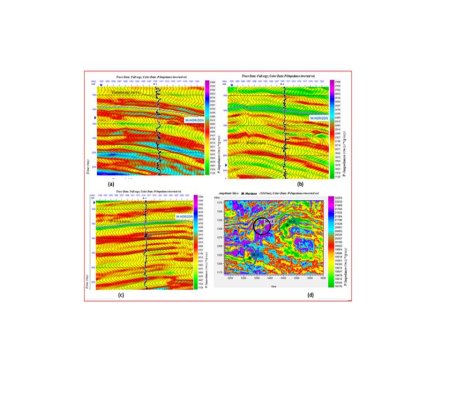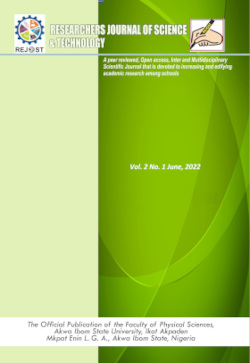Reservoir Characterisation Using Seismic Inversion Techniques for Mapping of Prospects
Keywords:
Hydrocarbon, Rock attributes, Lithology, seismic, reservoirAbstract
Reservoir Characterization using integrated 3-D seismic and well log data of M oil field, Niger Delta, was carried out with the aim of identifying reservoir rocks from qualitative interpretation of subsurface seismic view of M oil field through rock properties and acoustic impedance inversion analyzed in some selected reservoirs from the oil field. Rock attributes such as Lame’s parameters terms (λρ and μρ), Vp/Vs, P - Impedance, S - Impedance from available petrophysical data obtained from the field were discriminated, which better describe the reservoir of interest (M - 5000). Inversion of the post-stack seismic data was also carried out to generate acoustic impedance, VP/VS, IP, IS, λρ and μρ volumes. Data slices of the inverted acoustic impedance volumes were then generated to observe the locations if along hydrocarbon charged sands, wet sands or shales channels. Three wells (M-1, M-2 and M-3) were analysed and M-5000 was identified as reservoir of interest. Inversion result in M oil field revealed that the P-wave / Gamma ray curve is bounded by the top of M-5000 on inverted volumes with the lowest values of VP/VS (1.9290), IP (18176), λρ (6.7), and μρ (18.68), which indicate hydrocarbon (gas) charged sands. It means that Gas saturation is detected at the depth interval of 6449 – 6537 m (88 m thickness) M-2. Based on these observations, we conclude that seismic inversion of the post-stack seismic data can be used as good indicator of lithology and pore fluid contrasts and to predict the presence of hydrocarbon accumulation in the porous gas and oil sands to reduce drilling risk.
References
References
Brown, A., (1997). Porosity variation in carbonates as a function of depth: Mississippian Madison Group, Williston Basin, in J.A. Kupecz, J. Gluyas, and S.Bloch, eds., Reservoir quality prediction in sandstones and carbonates: AAPG Memoir 69, p. 29-46.
Dufour, J., J. Squires, W. N. Goodway, A. Edmunds, and I. Shook, (2002). Integrated Geological and Geophysical interpretation case Study and Lamé Rock Parameter Extractions using AVO analysis on the Blackfoot 3C-3D seismic data, southern Alberta, Canada: Geophysics, 67, 27–37.
Doust, H., and Omatsola, E., (1990). Niger Delta, in, Edwards, J. D., and Santogrossi, P.A., eds., Divergent/ passive Margin Basins, AAPG Memoir 48: Tulsa, American Association of Petroleum Geologists, p. 239-248.
Ezekwe, J. N and Filler, S. L (2005). Modeling Deepwater Reservoirs, Paper presented at the SPE Annual Technical Conference and Exhibition, Dallas, Texas, October 2005. Paper Number: SPE-95066 - MS, https://doi.org/10.21-18/95066-MS
Goodway, B., Chen, T. and Downton, J. (1997). Improved AVO fluid detection and lithology discrimination using Lame petrophysical parameters; ‘λρ', ‘μρ', & ‘λ/μ fluid stack' from P and S inversions: 67th Annual International Meeting, SEG, Expanded Abstracts, 183-186.
Kelkar, M. and Perez, G. (2002). Applied Geostatistics for Reservoir Characteri-zation, SPE, Dallas, TX (2002). International Journal of Innovative Research in Science, Engineering and Technology Vol. 2, Issue 4.
Li, Y. Y., and Downton, J. (2000). Application of amplitude versus offset in carbonate Reservoirs: Re-examining the potential: 70th Annual International Meeting, SEG, Expanded Abstracts, 166 –169.
Nicolao, A., Durufuca, G., and Rocca, F., (1993). Eigenvalues and Eigenvectors of Linearized elastic inversion: Geophysics, 58, 670 -679. Niger Delta: American Association of Petroleum Geologists.
Rothman, D. H., (1985). Nonlinear inversion, statistical mechanics and residual statics estimation: Geophysics, 50, 2784 - 2796.
Russell, B. H., Hedlin, K., Flilterman, F. J., and Lines, L.R., (2003). Fluid-property discrimination with AVO: A Biot-Gassmann perspective: Geophysics, 68, 29-39.
Tarantola, A., (1986): A strategy for nonlinear elastic inversion of seismic data: Geophysics, 51, 1893 - 1903.
Tuttle, M. L. W., Charpentier, R. R. and Brownfield, M. E. (1999). The Niger Delta petroleum system: Niger Delta province, Cameroon, and Equatorial Guinea, Africa: http://greenwood.cr.us gs. gov/energy/ Won dEnergy/O F99-5 0H/ChapterA.htm#TOP

Downloads
Published
How to Cite
Issue
Section
License
Copyright (c) 2023 Researchers Journal of Science and Technology

This work is licensed under a Creative Commons Attribution-NonCommercial-NoDerivatives 4.0 International License.




